It’s not easy following up when you’re a superstar at 19 – just ask Khalid
By John Shand, Harriet Cunningham, Peter McCallum, James Jennings, Chantal Nguyen and Frances Howe
Khalid
Sydney Opera House Concert Hall, August 5
Reviewed by FRANCES HOWE
★★★½
The lights go up on five figures in grey suits walking across the stage. A man in white follows. If not for the reputation that casts a long shadow behind him, Khalid may have gone unnoticed.
Khalid made a name for himself early. At 19, within a year of graduating from a Texas high school as prom king, he released his debut album American Teen, which detailed all the youthful aspirations and joyful vanity that go with adolescence. A more mildly received second album followed plenty of vocal features on other people’s songs.
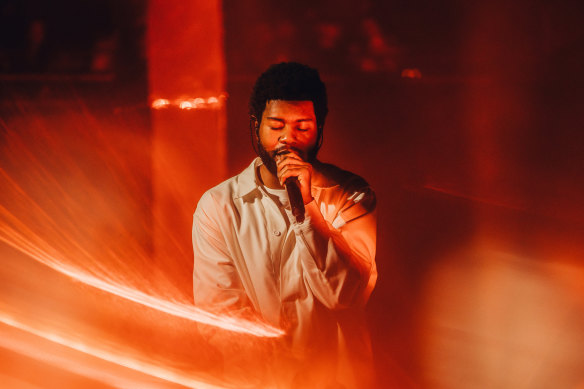
Khalid first burst onto the scene aged just 19.Credit: Jordan Munns
Reeling from teenage success, a five-year hiatus followed until last week’s release of his third album Sincere, which, in a world exclusive, he plays for the first time in full, in order, on this night at the Opera House.
Despite the upbeat start of Adore U, Everything We See and Altitude, it’s obvious Khalid has grown out of his earlier releases. He’s no longer young, dumb or broke, as he once identified. The love songs that follow are no longer a teenager’s unfounded yearnings – on Broken Khalid is speaking from a tarnished experience.
As he cycles through the rest of the 16-track album, the almost entirely seated audience rallies a little behind the album’s first single, Please Don’t Fall in Love With Me, the sentimental implications of Long Way Home and the sunny guitar on Heatstroke. The five-strong dance troupe feels like overkill.
This album is more wintry than his past two but Khalid is clearly having fun, joyfully addressing every part of the Opera House; yet even the fans who have waited years to see him again seem muted in comparison. This all changes when Khalid finishes his run through Sincere and plays that early hit Young, Dumb & Broke. The entire room rises to its feet and a forest of phones appears to record the moment.
Khalid follows up with more of the songs that first made him famous, including Marshmello’s Silence, Billie Eilish’s Lovely and his own debut single Location.
It was a gig of two halves. And, as though we were at our own high school reunion, the prom king reaffirmed his status by making the same jokes that once gave him that coveted yearbook spot.
Khalid plays a second show at the Concert Hall on August 6.
Silence & Rapture
City Recital Hall, August 2
Sydney Opera House (August 18)
Reviewed by CHANTAL NGUYEN
★★★★
Composer Igor Stravinsky observed about creativity: “The stained-glass artists of Chartres [Cathedral] had few colours, and the stained-glass artists of today have hundreds of colours but no Chartres. Not enlarged resources then, but men and what they believe.”
JS Bach and Arvo Part, both musical legends and men of deep Christian faith, composed for what they believed. Their music – veritable Chartres of harmony and longing – shares an inescapable theology and transcendent beauty despite being written three centuries apart. In an age of increasing secularism, Part’s music seems to satiate a lost sense of God: since the 2000s, he has frequently been named the world’s most-performed living composer. He famously quipped: “If anybody wishes to understand me, they must listen to my music; if anybody wishes to know my philosophy, then they can read the Church Fathers.”
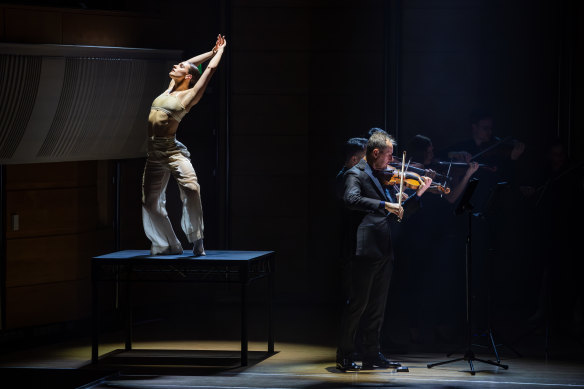
SDC’s Rafael Bonachela has choreographed the dance equivalent of chamber music.Credit: Daniel Boud
This season the Australian Chamber Orchestra presents Silence & Rapture, a spiritual meditation featuring Bach and Part’s music, visually lifted by a gorgeous collaboration with Sydney Dance Company. Structured around imagery of the three gardens of Salvation History – Eden, Gethsemane, and Heaven – it plays almost like a mosaic oratorio, depicting wounds then healing in the relationship between God and man.
The ACO is at home in the Bach, soaring ebulliently through movements from various cantatas and sonatas for solo violin and cello. The Part is richly emotive, though the faster pieces are less assured – Fratres especially would benefit from greater resonance and steadier pitch.
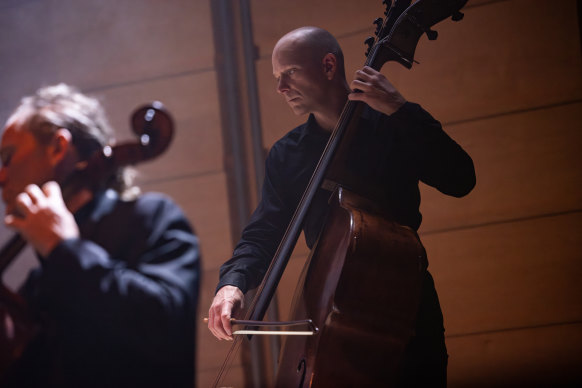
ACO bassist Maxime Bibeau.Credit: Daniel Boud
For opera and choral fans, British countertenor Iestyn Davies makes a striking Australian debut. Blessed with a rich, velvety lower register and an upper voice of soaring molten gold, Davies shines in the more lyrical, sensuous pieces where his sustained notes bloom like growing daybreak. His renditions of Bach’s Erbarme Dich – where the ACO likewise excel – and Part’s My Heart’s in the Highlands and Vater Unser are heart-stopping.
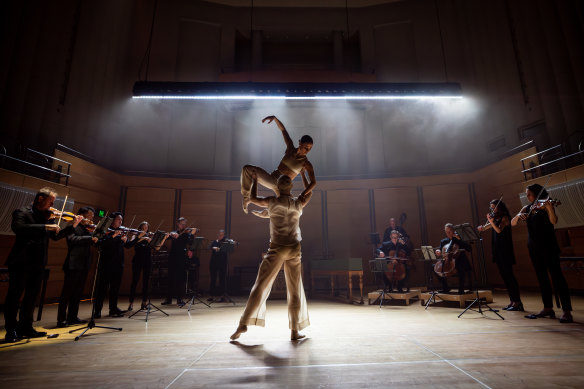
The multidisciplinary combination of instruments, voice and movement is ultimately winning.Credit: Daniel Boud
Dance lovers also have the unusual chance of seeing SDC’s Rafael Bonachela, constrained by stage space, choreographing the dance equivalent of chamber music. All intimacy, complex detailed movements, and beautifully phrased shapes, its luminous choreography danced to perfection by Liam Green and Emily Seymour, one of Australia’s most exciting dance talents.
This multidisciplinary combination of instruments, voice and movement is ultimately winning. If theologians describe Salvation History as “the greatest love story ever told”, then the ACO, Davies, and SDC have put a lot of love into this gorgeous curation.
The Woman in Black
Theatre Royal
August 1
Until August 17
Reviewed by HARRIET CUNNINGHAM
★★★★
When John Waters does bad acting, it’s really bad. So bad that at the start of The Woman in Black, you worry this is going to be another one of those stilted, museum-piece productions that tour the world, showing us how it’s done properly. In some ways, The Woman in Black is one of those productions; this is much the same show you would see if you went to the Fortune Theatre in London’s West End, where it ran for 33 years before closing in 2023.
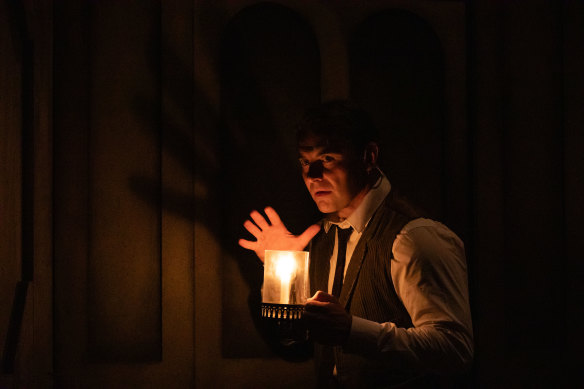
Daniel MacPherson in a scene from The Woman in Black.Credit: Justin Nicholas
In the opening scene, Waters’ character, Arthur Kipps, is meeting with the Actor (Daniel MacPherson) to finesse the telling of a story that has haunted him most of his life. Kipps reads, fast and expressionless, from a fat sheaf of papers, and we laugh at his hopeless inadequacy. It’s so bad it’s good: a gag that gets a big laugh every time, even though we know it’s coming. But there’s an urgency to Kipps’ awkwardness. The story must be told, and that’s why he’s in a theatre, seeking help from the Actor.
As a young solicitor, Arthur Kipps is tasked with tying up the loose ends of the deceased estate of a reclusive widow. During his time at Eel Marsh House, he learns about a vengeful wraith that haunts the house in the wake of a family tragedy. Much spookiness ensues.
The power of theatre is the beating heart of this deliciously gothic ghost story. We start by laughing at Kipps but end up utterly enthralled as Waters and MacPherson transform themselves into myriad characters. There’s no need for high-tech trickery. It’s all pure skill. The sound – beautifully designed by Rod Mead — of seabirds or carts and cars is enough to conjure up a desolate marsh or a busy London street.
The magic of lighting, stage smoke, and a plain scrim (designed by Michael Holt) does the rest. The beauty of it all is that we know it is theatre; we can see the puppet’s strings, but in spite of that, we still jump, gasp, and sit in suspense, waiting for the next surprise. And, like every good ghost story, the last surprise is the best.
Ladyhawke
Metro Theatre, August 2
Reviewed by JAMES JENNINGS
★★★★
Here’s a gig that provides a hefty double dose for nostalgia fans: firstly, nostalgia for the electro-pop scene that emerged in the mid-to-late 2000s (see: Cut Copy, La Roux, Empire of the Sun and, of course, Ladyhawke); then there’s the fact the hipster-approved genre is itself a nostalgic, semi-ironic update of ’80s synth-pop.
That may all sound a bit too pop-will-eat-itself for its own good, but the fact remains that Ladyhawke’s (aka New Zealander Pip Brown) 2008 self-titled debut album is packed with electro-pop bangers – five of which became singles – that deserve revisiting.
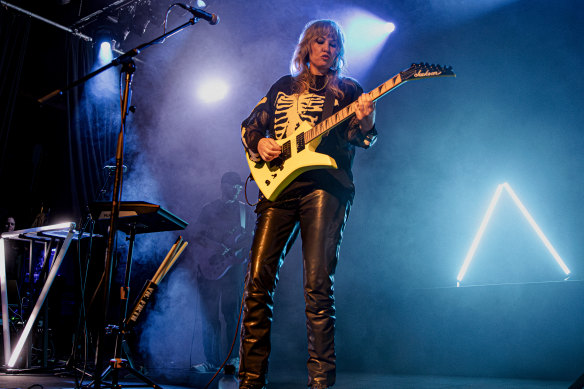
Airy synths and angular rock riffs: Pip “Ladyhawke” Brown.Credit: Chris Neave
Billed as a 15th-anniversary album tour in which the record will be performed front-to-back, Brown and her two bandmates conjure an ’80s-worshipping fever dream on stage with neon lights, a sea of synthesisers and fluoro guitars.
It all sounds like the perfect set-up for a hands-in-the-air celebration and that’s precisely what the gig becomes, especially when Brown and co reach third song My Delirium. A platinum-selling Top 10 hit in Australia, the song has lost none of its charm, its combo of airy synths and angular rock riffs still a surefire party starter.
The album tracks hold up perfectly fine (Love Don’t Live Here features a chunky guitar riff that would make Jack White jealous), but it’s the abundance of killer singles – Back of the Van, Paris Is Burning, Dusk Till Dawn and Magic – that lift the gig from good to great.
Brown has a quirky, slightly awkward Kiwi charm to her (“This is why I don’t talk normally,” she quips), even engaging the audience to help decide how the show should end: put on the charade of walking off-stage and coming back for an encore, which may kill the momentum, or simply keep going?
The crowd overwhelmingly votes for the latter, resulting in a selection of songs from across Brown’s catalogue that culminates in the night’s most euphoric moment: Brown giving it her all on a cover of Pnau’s hit 2008 single Embrace, which is about as crowd-pleasing as dance music gets.
Old tropes die hard though, it seems, with Brown responding to the crowd’s enthusiastic calls for more with an honest-to-God spontaneous encore, where she plays My Delirium one more time – a generous offering to an audience who would’ve quite happily electro-popped with Ladyhawke until the early hours.
Cosi fan tutte
Opera Australia
Joan Sutherland Theatre, Sydney Opera House
August 1
Until August 17
Reviewed by PETER McCALLUM
★★★★
It’s hard to be woke with Mozart’s Cosi fan tutte. Director David McVicar’s 2016 production, revived here with a talented young cast, places the opening in a leathery men-only club, where officers smoke, drink and argue about women. The tone is robust and competitive and the musical phrases, under conductor Zoe Zeniodi, are straightforward without ingratiating roundedness.
The rest of the action is set amid the beguiling lines of the women’s opulent Neapolitan mansion, a domain ripe for importunate male pleading until they yield, at which point it is all the women’s fault. Designer Moritz Junge, with lighting by David Finn, gives the external space an attractive depth of field and a hint of kitsch in the glistening distant bay, while the internal rooms are private and personal, inviting the audience as voyeurs.
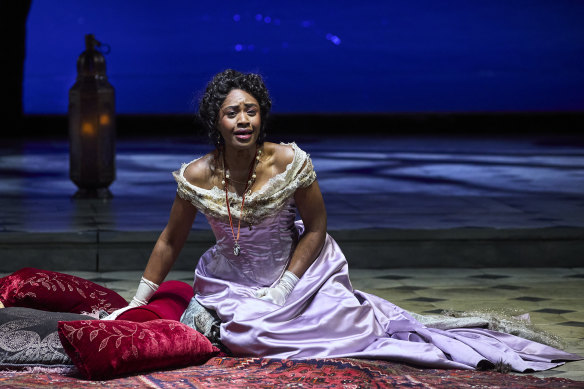
Nardus Williams brought a dramatic intensity to her role as Fiordiligi. Credit: Keith Saunders
McVicar presents the full work uncut to allow each character ample time to reveal their inconsistencies, and, faithful to the ambiguity of Mozart and librettist Da Ponte’s text, refuses to fix things up at the end, leaving everyone sadder and not much wiser.
As Fiordiligi, Nardus Williams had a voice of textured silkiness in mid register and attractive liquid colours in the high range particularly in quiet moments. Her low register was soft, well-pitched and without heft, making her an interesting choice for this role with its volatile lines and wide leaps (notably in come scoglio). Dramatically she fumed and changed with great intensity.
Helen Sherman’s voice as Dorabella had clear, bright colour and uncomplicated evenness, and she delighted in the character’s dalliance with fickleness. Alexandra Oomens inhabited the can-do versatility of the servant role, Despina, with engaging, pert energy and sang with coloured focus, allowing occasional flashes of brightness at one end and pinched, funny-voice impersonations at the other. As Ferrando, Filipe Manu had well-honed edge, singing the opening with assertive impatience, which informed his characterisation throughout.
Un’aura amorosa had smooth arched line. As Guglielmo, Nathan Lay had cut-through directness, producing a well-shaped melodic curve. His dramatic persona evolved from unfounded confidence at the start to undisguised irritation at the close, boding ominously for the prospects for domestic bliss after the curtain came down.
Richard Anderson’s Don Alfonso had the insolent smugness of people who are always right and sang with strongly edged, well-tempered sound, providing the foundation and sometimes the dominant voice in ensembles. Zeniodi conducted with clear edges, avoiding overindulgence and excess.
From my vantage point, there were moments when the overall sound highlighted individual strands rather than cohesive blend, though this was likely an acoustic rather than a performance issue. Zeniodi allowed the occasional provocative prods in the details of Mozart’s score to emerge without over-rhapsodising or airbrushing.
The Jesus and Mary Chain
Enmore Theatre, August 1
Reviewed by JAMES JENNINGS
★★★★
Long before Oasis’ Liam and Noel Gallagher turned rock’n’roll sibling rivalry into a sport, Glaswegian brothers Jim and William Reid were getting wasted and throttling each other on (and off) stage, their volatile sets sometimes lasting barely 15 minutes.
Incredibly, the Jesus and Mary Chain only split up for eight of their 41 years as a band and, although singer-songwriter Jim and lead guitarist-songwriter William barely acknowledge each other during this gig, there’s no sense of tension or of feeling a punch will be thrown.
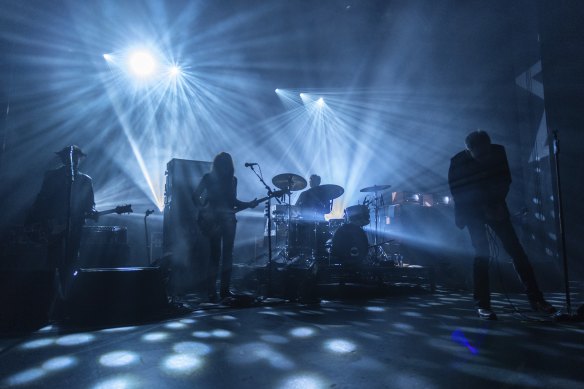
Back for Enmore: The Jesus and Mary Chain.Credit: Rhett Wyman
One of rock’s most dysfunctional bands seems to have grown up a bit, and they’ve never sounded tighter live. Thrillingly, the Reids and the three musicians joining them – including Primal Scream bassist Simone Butler, who sings Hope Sandoval’s part on Sometimes Always – summon that classic, distortion-heavy JAMC sound with ease.
While on record the songs on new album Glasgow Eyes don’t always conjure up the same magic of yore, the beefed-up live versions slot seamlessly into the set list. Recent single Jamcod crackles with too-cool-for-school attitude and energy, and 2017’s All Things Pass sounds straight from the band’s ’80s prime.
Rather than just play the new stuff with a couple of crowd favourites chucked in to keep everyone happy, the Reids are generous regarding the amount of beloved older material they mine for this night’s show.
Head On, their 1989 single that’s as perfect as indie rock love songs get, is the second song played, and early career favourites like Happy When It Rains, Some Candy Talking, Taste of Cindy and Just Like Honey (of course) are all expertly deployed.
There’s not much banter, but there doesn’t need to be: the Jesus and Mary Chain have always excelled at standing around looking impeccably cool, and on this night, framed mostly in silhouette and engulfed in swirling smoke, that box is firmly ticked.
Now in their 60s, the Reid brothers sign off by reminding us age hasn’t dulled them one bit, and that the violence these days is strictly channelled into the music. Final song Reverence pummels us with face-melting feedback and blinding strobe lights, the perfect, abrasive end for a band that instinctively finds the beautiful in the ugly, and the ugly in the beautiful.
THEATRE
UNCLE VANYA
Ensemble Theatre, July 31
Until August 31
Reviewed by JOHN SHAND
★★★★★
Until now, an “adaptation” of a classic tended to be a synonym for a bastardisation. Usually translated from another language, these classics come to us more in the image of the adaptor than the originator: high art rendered low by inferior intellect and artistry.
But it can work. Commissioned by Ensemble Theatre’s artistic director Mark Kilmurry, Joanna Murray-Smith’s adaptation of Uncle Vanya gives us pure Chekhov, just gently refocused through a prism of now, to bring us closer, probably, to the experience of an 1899 Moscow audience. She lets us in on the humour that hasn’t necessarily survived the intervening 125 years in direct translation. If many words are hers rather than Chekhov’s, the spirit of Chekhov is gloriously intact.
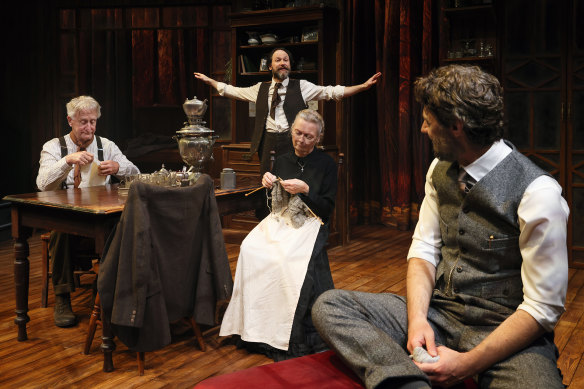
John Gaden, Vanessa Downing, Yalin Ozucelik, Tim Walter in Uncle VanyaCredit: Prudence Upton
How black-humoured that spirit is. It can be as dark as Beckett, with just a flicker of light at the end of life’s tunnel of gloom. According to Sonya, perhaps the least self-delusional character, we don’t reach that light until we die, which is grim consolation, although in her mind it’s sufficient justification for abiding the suffering.
Vanya, by contrast, in response to a remark about the pleasant weather early on, retorts “a perfect day for hanging oneself”, and later steals Doctor Astrov’s morphine with a view to doing a quieter job.
I’ve never laughed at Uncle Vanya so much while still feeling Chekhov’s intended sympathy for all the characters. Yes, Sonya, Astrov and Nanny apart, they are foolish, petty, hypocritical, self-absorbed creatures, yearning for what they can’t have and deceiving others and themselves at every turn. Yet Chekhov’s point is they aren’t bad. They’re capable of giving and receiving love, being amused or amusing, and just possibly, like Astrov, of doing some good.
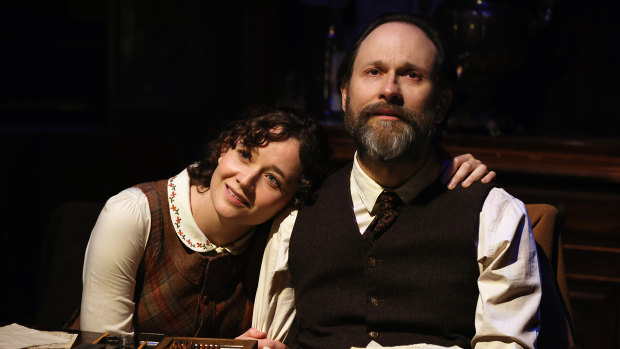
Abbey Morgan, here with Yalin Ozucelik, wins hearts as Sonya. Credit: Prudence Upton
Receiving sympathy from each other is another matter. Much of the humour lies in the characters’ shrugging aside each other’s suffering to dramatise their own – like so many playwrights, with the other characters their puppets.
Kilmurry’s sharp casting has each actor amplifying the inner lives of these deeply flawed people. Yalin Ozucelik is such a wired Vanya that his manic attempt to shoot Serebryakov is not just hilarious but plausible. He speaks with no filter between brain and mouth and resents the hand that life has dealt him even more than does Yelena.
As the latter, stuck with a husband 30 years her senior, Chantelle Jamieson gives her most complete performance so far, trying to suppress her bitterness and extravagant passions amid her equally extravagant boredom.
Abbey Morgan sweetly meets the challenge of Sonya, who must be awkward without the acting being so. Desperate in her unrequited love for Astrov, she, in her 20s, is already the ultimate stoic, resigned to work and death – and, winning our hearts, wishes the others would just calm down.
Tim Walter ensures Astrov credibly has Sonya and Yelena falling for him, as much for his mind as any animal magnetism. Chekhov-like, he’s a selfless, lonely doctor, who consoles himself with vodka and meanwhile implements reforestation projects to steady the climate – and this over a century ago!
David Lynch is a fabulously pompous Serebryakov, red-faced with fury when his word is not law, and John Gaden (Telyeghin) and Vanessa Dowling (Nanny/Maryia) are typically convincing and entertaining.
Kilmurry uses Nick Fry’s charming set in such a way that, with the audience occupying three sides of the Ensemble’s stage, we stare at the actors’ backs less than usual. It’s as if he pulls focus between them for us – rather like Chekhov’s text does.